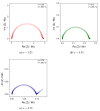Highly Conducting Li(Fe1- xMnx)0.88V0.08PO4 Cathode Materials Nanocrystallized from the Glassy State (x = 0.25, 0.5, 0.75)
- PMID: 34771963
- PMCID: PMC8585229
- DOI: 10.3390/ma14216434
Highly Conducting Li(Fe1- xMnx)0.88V0.08PO4 Cathode Materials Nanocrystallized from the Glassy State (x = 0.25, 0.5, 0.75)
Abstract
This study showed that thermal nanocrystallization of glassy analogs of LiFe1-xMnxPO4 (with the addition of vanadium for improvement of glass forming properties) resulted in highly conducting materials that may be used as cathodes for Li-ion batteries. The glasses and nanomaterials were studied with differential thermal analysis, X-ray diffractometry, and impedance spectroscopy. The electrical conductivity of the nanocrystalline samples varied, depending on the composition. For x=0.5, it exceeded 10-3 S/cm at room temperature with an activation energy as low as 0.15 eV. The giant and irreversible increase in the conductivity was explained on the basis of Mott's theory of electron hopping and a core-shell concept. Electrochemical performance of the active material with x=0.5 was also reported.
Keywords: cathode materials; electron hopping; high conductivity; nanocrystallization; olivine.
Conflict of interest statement
The authors declare no conflict of interest.
Figures









References
-
- Lewis G.N., Keyes F.G. The potential of the lithium electrode. J. Am. Chem. Soc. 1913;35:340–344. doi: 10.1021/ja02193a004. - DOI
-
- Padhi A.K., Nanjundaswamy K.S., Goodenough J.B. Phospho-olivines as Positive-Electrode Materials for Rechargeable Lithium Batteries. J. Electrochem. Soc. 1997;144:1188. doi: 10.1149/1.1837571. - DOI
-
- Ling J., Karuppiah C., Krishnan S.G., Reddy M.V., Misnon I.I., Rahim M.H.A., Yang C., Jose R. Phosphate Polyanion Materials as High-Voltage Lithium-Ion Battery Cathode: A Review. Energy Fuels. 2021;35:10428–10450. doi: 10.1021/acs.energyfuels.1c01102. - DOI
-
- Herrera J.O., Camacho-Montes H., Fuentes L.E., Lvarez-Contreras L. LiMnPO4: Review on Synthesis and Electrochemical Properties. J. Mater. Sci. Chem. Eng. 2015;3:54.
Grants and funding
LinkOut - more resources
Full Text Sources

